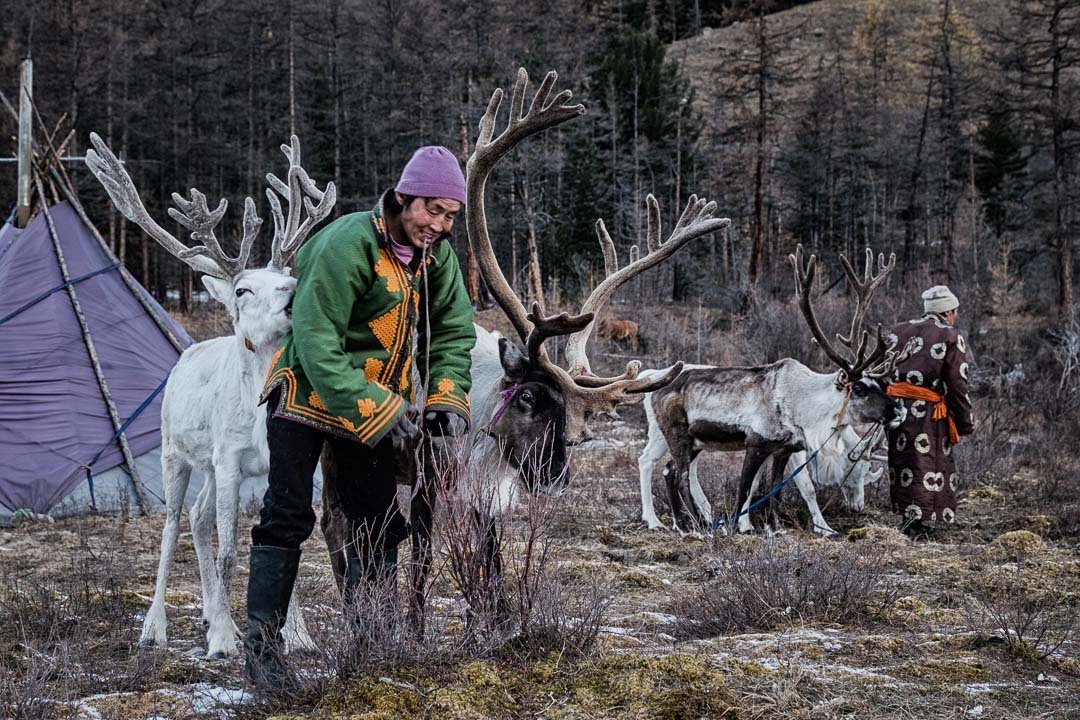The Tsaatan’s origins hail from Tuva, a small independent republic squeezed between Russia and Mongolia, which was eventually absorbed into Russia and splitting the reindeer communities. Mongolia adopted many displaced Tsaatan families who moved into the Taiga region where they have, ever since, roamed. Their lifestyle, revolves around caring for their beloved reindeer, has changed little. There are an estimated 1,500 reindeer and fewer than 500 Tsaatan people.
“…fewer than 500 Tsaatan people.”
The overall Tsaatan community is made up two-dozen separate, extended family collectives. Each collective is constantly on the move every 5-10 days. Consequently, locating a temporary Tsaatan home requires a stroke of luck mixed with some local intelligence. It took several days driving across snow-white plains to the foot of the Taiga region, then riding by horse across treacherous ice-covered forest floors before meeting a family packing-up the last of their belongings. They’d already been there for 5days. It was time to move-on and not over graze the area.
A young couple, their uncle and cousin remained behind to ferry the last heavier belongings onto the next camp over several days. Inclement weather meant they were happy to hang around a bit longer sharing a tee-pee-like tent with few mod-cons - a small solar panel, radio and telephone - that allowed them to keep in touch with family and up-to-date on local news too. The most important, superseding regional politics, was weather and sighting of wolves. There’d been a several attacks on reindeer in the past month.
The Tsaatan rely on their reindeer for transport and milk. They fashion the antlers, which drop off regularly, into decorations or useful instruments. They do not consciously kill their reindeer for meat.
The Tsaatan have intricate knowledge of surviving the cold climes of the Taiga which is passed on through ‘doing’ when travelling, hunting and herding. These survival skills are not written down anywhere as they do not have a written language. Unfortunately, the spoken dialect, as the younger generation moves into the world outside the Taiga, is steadily disappearing. So, the survival stories, too, are evaporating.
“…the spoken dialect is steadily disappearing.”
The Mongolian authorities are cognisant of the plight of the Tsaatan culture as the younger people start to adapt towards permeant establishments. Efforts, for those Tsaatan who continue as nomadic reindeer herders in the Taiga, are afoot to provide protection against exploitation, including monitoring access to Tsaatan communities and ensuring respectful engagement, family record keeping and, importantly, archival of culture and customs led by Tsaatan community elders.
Already the original dress of the Tsaatan has migrated away from hunted wolf-fur coats into traditional Mongolian dels and the Shamanistic practices of the past is limited.
Against this backdrop, it was comforting to uncover, some young Tsaatan couples consciously electing to pursue their traditional lifestyle in favour of the outside world and passionately share their experience of being the last reindeer people.
“…experience of being the last reindeer people.”
















